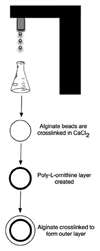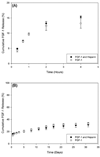Synthesis of multilayered alginate microcapsules for the sustained release of fibroblast growth factor-1
- PMID: 20725969
- PMCID: PMC2944012
- DOI: 10.1002/jbm.a.32883
Synthesis of multilayered alginate microcapsules for the sustained release of fibroblast growth factor-1
Abstract
Alginate microcapsules coated with a permselective poly-L-ornithine (PLO) membrane have been investigated for the encapsulation and transplantation of islets as a treatment for type 1 diabetes. The therapeutic potential of this approach could be improved through local stimulation of microvascular networks to meet mass transport demands of the encapsulated cells. Fibroblast growth factor-1 (FGF-1) is a potent angiogenic factor with optimal effect occurring when it is delivered in a sustained manner. In this article, a technique is described for the generation of multilayered alginate microcapsules with an outer alginate layer that can be used for the delivery of FGF-1. The influence of alginate concentration and composition (high mannuronic acid (M) or guluronic acid (G) content) on outer layer size and stability, protein encapsulation efficiency, and release kinetics was investigated. The technique results in a stable outer layer of alginate with a mean thickness between 113 and 164 μm, increasing with alginate concentration and G-content. The outer layer was able to encapsulate and release FGF-1 for up to 30 days, with 1.25% of high G alginate displaying the most sustained release. The released FGF-1 retained its biologic activity in the presence of heparin, and the addition of the outer layer did not alter the permselectivity of the PLO coat. This technique could be used to generate encapsulation systems that deliver proteins to stimulate local neovascularization around encapsulated islets.
Figures








Similar articles
-
Multilayered microcapsules for the sustained-release of angiogenic proteins from encapsulated cells.Am J Surg. 2010 Nov;200(5):655-8. doi: 10.1016/j.amjsurg.2010.08.001. Am J Surg. 2010. PMID: 21056148 Free PMC article.
-
New alginate microcapsule system for angiogenic protein delivery and immunoisolation of islets for transplantation in the rat omentum pouch.Transplant Proc. 2011 Nov;43(9):3262-4. doi: 10.1016/j.transproceed.2011.10.030. Transplant Proc. 2011. PMID: 22099771 Free PMC article.
-
Generation of alginate microspheres for biomedical applications.J Vis Exp. 2012 Aug 12;(66):3388. doi: 10.3791/3388. J Vis Exp. 2012. PMID: 22907205 Free PMC article.
-
Design of a bioartificial pancreas(+).J Investig Med. 2010 Oct;58(7):831-7. doi: 10.231/JIM.0b013e3181ed3807. J Investig Med. 2010. PMID: 20683347 Free PMC article.
-
Alginate-based microcapsules generated with the coaxial electrospray method for clinical application.J Biomater Sci Polym Ed. 2017 Sep;28(13):1245-1255. doi: 10.1080/09205063.2017.1318030. Epub 2017 Apr 20. J Biomater Sci Polym Ed. 2017. PMID: 28391767 Review.
Cited by
-
Fibrin-loaded porous poly(ethylene glycol) hydrogels as scaffold materials for vascularized tissue formation.Tissue Eng Part A. 2013 Jan;19(1-2):224-34. doi: 10.1089/ten.tea.2012.0120. Epub 2012 Sep 24. Tissue Eng Part A. 2013. PMID: 23003671 Free PMC article.
-
Multilayered microcapsules for the sustained-release of angiogenic proteins from encapsulated cells.Am J Surg. 2010 Nov;200(5):655-8. doi: 10.1016/j.amjsurg.2010.08.001. Am J Surg. 2010. PMID: 21056148 Free PMC article.
-
Encapsulated islet transplantation: strategies and clinical trials.Immune Netw. 2013 Dec;13(6):235-9. doi: 10.4110/in.2013.13.6.235. Epub 2013 Dec 20. Immune Netw. 2013. PMID: 24385941 Free PMC article. Review.
-
Poly-L-ornithine enhances migration of neural stem/progenitor cells via promoting α-Actinin 4 binding to actin filaments.Sci Rep. 2016 Nov 22;6:37681. doi: 10.1038/srep37681. Sci Rep. 2016. PMID: 27874083 Free PMC article.
-
This paper is a winner in the Undergraduate category for the SFB awards: Evaluation of the tissue response to alginate encapsulated islets in an omentum pouch model.J Biomed Mater Res A. 2016 Jul;104(7):1581-90. doi: 10.1002/jbm.a.35769. Epub 2016 May 18. J Biomed Mater Res A. 2016. PMID: 27144389 Free PMC article.
References
-
- Shapiro AM, Lakey JR, Ryan EA, Korbutt GS, Toth E, Warnock GL, Kneteman NM, Rajotte RV. Islet transplantation in seven patients with type 1 diabetes mellitus using a glucocorticoid-free immunosuppressive regimen. N Engl J Med. 2000;343(4):230–238. - PubMed
-
- Menger MD, Messmer K. Pancreatic islet transplantation: isolation, separation, and microvascularization. Wien Klin Wochenschr. 1992;104(15):429–433. - PubMed
-
- Avila JG, Wang Y, Barbaro B, Gangemi A, Qi M, Kuechle J, Doubleday N, Doubleday M, Churchill T, Salehi P, et al. Improved outcomes in islet isolation and transplantation by the use of a novel hemoglobin-based O2 carrier. Am J Transplant. 2006;6(12):2861–2870. - PubMed
-
- Opara EC, Kendall WF., Jr Immunoisolation techniques for islet cell transplantation. Expert Opin Biol Ther. 2002;2(5):503–511. - PubMed
-
- Beck J, Angus R, Madsen B, Britt D, Vernon B, Nguyen KT. Islet encapsulation: strategies to enhance islet cell functions. Tissue Eng. 2007;13(3):589–599. - PubMed
Publication types
MeSH terms
Substances
Grants and funding
LinkOut - more resources
Full Text Sources
Other Literature Sources

